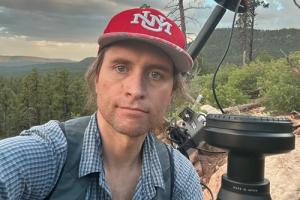Grad’s Environmental Impact Mushrooms with JHU Credentials
Published July 16, 2025
 If anyone can put the fun in fungi, it’s Joey Smallwood.
If anyone can put the fun in fungi, it’s Joey Smallwood.
Forever a fun-seeker, the former professional skier, mountain guide, and scuba instructor has turned the passion that he experienced from these extreme professions into an academic pursuit to save the environments that sustains them.
A 2025 graduate of Johns Hopkins’ MS in Environmental Science and Policy program, Smallwood’s studies at JHU led directly to his pursuit of a PhD at the University of New Mexico, where he is studying with the Taylor Lab.
“I have always been interested in fungi and the concept that they can save the world. They can even eat plastics,” said Smallwood, a native of Santa Fe, NM who once sold the mushrooms he grew at a local farmer’s market. “We are learning more every day about the medicinal uses of fungi. On the forest side, we are just discovering that trees are really dependent on their fungi network to transport sugars and nutrients. I learned in Dr. Jerry Burgess’ Forest Ecosystems course, one of the most challenging but most fun courses I have ever taken, that there are so few fungal ecologists who focus solely on forest ecology in the world. I decided in his course that I need to be one of them.”
Even prior to officially beginning his PhD program, Smallwood leads a collaborative study in the mountains just east of Santa Fe on how forest management can affect fungi, tree physiology, and the microclimate as forests face mounting heat and drought stress due to climate change.
“We are using DNA sequencing on fungal communities and gas exchange measurements in tree needles to assess physiological stress, ecosystem resilience, and potential reductions in fire severity and risk,” said Smallwood, who admittedly carries a folder of notes from Burgess’ course with him. “We are deploying soil moisture and wind loggers to understand the changes in the climate. This work really bridges all the things I learned at Hopkins into one cool study that has never been done in these mountains. That gets me so excited.”
Smallwood is also starting a second project in the Jemez Mountains. He is developing a predictive model using the geographic information system skills he honed with his Hopkins’ GIS certificate to predict the presence of porcini mushrooms, important bioindicators of forest health. He hopes to use his data to inform the U.S. Forest Service of the impact of various treatment methods so they can optimize their forest management strategies to keep the trees as low stress as possible, while still lowering fire danger.
Smallwood’s experiences – from the tops of mountains, to under the ocean, to deep in the wilderness – have given him a unique environmental perspective. As a competitor in “Big Mountain Free Riding” in Colorado, Switzerland, and France, where he would exit a helicopter and make his way down an unmarked mountain, to his guides through the glaciers and terrain in Wrangell – St. Elian National Park in south central Alaska, to leading scuba expeditions in Maui, Hawaii, he has personally encountered the effects of global warming and other adverse environmental impacts.
“It was really sad when I was in Maui to see the coral bleaching all around me and to see, at depths of even 100 feet, coral and fish dying in 83-degree water,” he said. “I enrolled in an environmental science program at the University of Hawaii when I realized that research and scholarship were the most meaningful ways I could contribute to planetary health, because before that I was just doing recreational education. I returned to Santa Fe to finish my bachelor’s degree at the University of New Mexico.”
In Johns Hopkins, Smallwood found everything he wanted in a graduate program, a combination of policy, science, and GIS spatial tools.
“Johns Hopkins provided everything I needed to develop the fluency that I was seeking,” Smallwood said. “It taught me how to bring all of those pieces together to create a compelling research narrative that was more holistic than I was able to create before I came to Hopkins. One of my best decisions was to listen to the advice of Program Director Cassandra Hansen and add a GIS graduate certificate to my degree. It has given me a very unique tool set and allows me to work with large data sets, while staying grounded in the latest ecological research. It is cool that I developed the ability to connect GIS, ecology, and fungal biology in a way that I think enhances the accuracy and precision of my work today.
“After I complete my PhD, I hope to choose a professional path that is best for the earth and that helps the environment in this time of crisis,” Smallwood continued. “I could be incredibly happy working in any of the ecosystems I’ve experienced. I would encourage anyone who has a passion like mine for the environment to look into Johns Hopkins and to use the program’s flexibility to explore when really matters to you. The work is intense but deeply rewarding. Lean into the challenge. You will find that your professors and some of your fellow students are the most brilliant and supportive people you will ever learn from. It was definitely the best and most transformative experience of my life.”
Attention: Students and Alumni
Are you a current AAP student or alumni and want to share your accomplishments?
Interested in pursuing a graduate degree at Johns Hopkins University?
Request information to learn more or apply here.